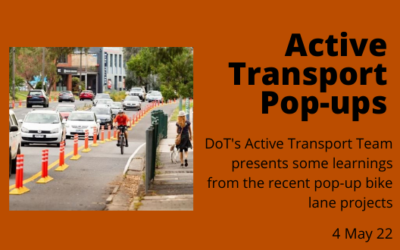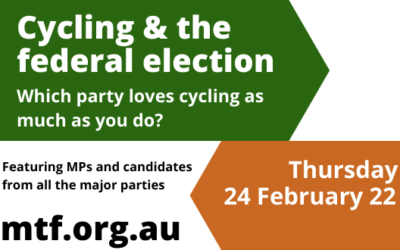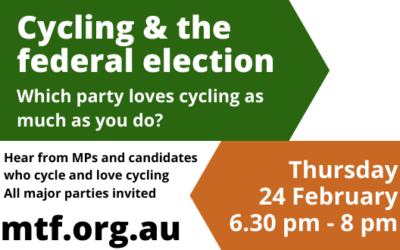GETTING THE WHEELS TURNING, FAST AND ALMOST FREE

Tom MELICAN, Cycling ambassador
Cr Tom Melican is passionate about cycling.
Former mayors want to make the most of COVID inspired walking and cycling by making it easier for councils to lower speed limits on local side roads.
Cycling and walking may not be as politically compelling as tunnels and trains, but practically cost-free ideas emerging from local government could deliver powerful, profound and positive change in the way Melbournians choose to make short trips.
Here’s a thought. Simply by reducing the speed limits on selected suburban streets more people will choose to walk or ride for many local trips.
And before car drivers start honking their horns in protest, we are not talking about main streets or busy thoroughfares. This idea applies only to selected local side streets chosen by councils because they are suitable and provide easy access to common destinations. For drivers, it only adds seconds to their trips, if it makes any difference at all.
Our simple plan is to enable councils to reduce speed limits to 30 kph on selected streets to quieten traffic and make local trips by foot or bike much more attractive. This will capitalise on one of the few benefits of the COVID restrictions, namely more local cycling and walking. It will also reduce the Department of Transport’s lengthy and time-consuming assessment of individual Council applications for speed reductions across 79 Councils.
It also sets up our suburbs to better cope with the long-term impacts of COVID safe social distancing and changing work habits. With more people working and learning at home, we’ve seen bike shops booming and footpaths buzzing as trips to local destinations like takeaways and food shops have become daily highlights.
This fundamental shift in behaviour has been imposed by COVID; but it could be the catalyst for clever, easy and inexpensive changes to make cycling and walking more attractive for more people.
Giving local councils the power to reduce speed limits to 30 kms on council local roads, would make cycling and walking more attractive without expensive infrastructure. All it takes is some signage, community information and education. It could also be done in a pop-up style, without extensive works or planning – and reversed easily if required.
International data, Monash University Accident Research Centre (MUARC) reports and a recent 30km trial in Fitzroy-Collingwood local streets assessed by MUARC, all show that 30 km limits reduces crashes and make both pedestrians and cyclist feel safer. A swag of positive side effects result: more kids walking to school; more people cycling for local trips; quieter and friendlier streets; and of course, a multiplicity of health benefits. This is why 30km/h is a common limit on local streets in Europe.
Working from home also changes what many need from their local economy. The coffee shop of choice will be a walk or ride away; the work break can also be a local shop break; getting the kids could be a walk instead of a drive. These are changes that will be welcomed by many local businesses struggling for a post-COVID future.
Predictions that up to one in five people will now work regularly from home, at least several days a week, indicate a seismic shift in the way we use our streets and suburbs. The commute to work will be less important, while the trip to local destinations becomes more important. Pre COVID, 20% of car trips were less than 2 kms, and 50% under 5 kms. If we are smart, we can change this to make walking and cycling the preferred mode for most local trips.
In the short term, it’s likely that traffic congestion will increase across Melbourne as more people use private cars instead of public transport for commuting. This only reinforces the importance of walking and cycling for local trips because it takes those trips off the busy, congested arterial roads.
By walking and cycling more, many Melbournians are already sending a message to their governments, now is the time to listen to them and act.
Cr Tom Melican is former Mayor of Banyule and Cr Jackie Fristacky was Mayor of Yarra. Both are passionate cyclists.
By walking and cycling more, many Melbournians are already sending a message to their governments.
RECENT POSTS
Pop-up progress
Four members of the DoT Active Transport Team discuss the learnings from the recent pop-up cycle lanes in Melbourne and suburbs.
Cycling & Federal election forum
Watch a recording of the forum with MPs and candidates from all the major parties discussing cycling.
Cycling & the federal election
An online forum about Cycling and the Federal election. Hear from all major parties to discover which party loves cycling as much as you do!
Victoria Walks: Understanding Pedestrian Crashes
Victoria Walks’ Duane Burtt presented the latest results of research into pedestrian crashes to the MTF November meeting.
New walking ambassador Cr Jodi Jackson
Talk the walk and walk the talk with our new walking ambassador
Study finds massive interest in cycling
July's meeting featured two fascinating presentations on cycling in the city, including new research that shows more interest in bike riding than previously documented.
MTF confirms ABC as strategic direction for 21-22
The March MTF meeting adopted a strategic plan for 20-21. The Plan focuses on Active transport, Buses and Choices.
Local flexibility on speed limits
Local flexibility on speed limits is a quick and low-cost way to make cycling safer and more popular
WALK AND RIDE TO BOOST THE LOCAL ECONOMY
It was not a coincidence that the MTF August meeting heard two presentations on active transport. Not only is it one of our top three ABC issues, it’s also very COVID current.




